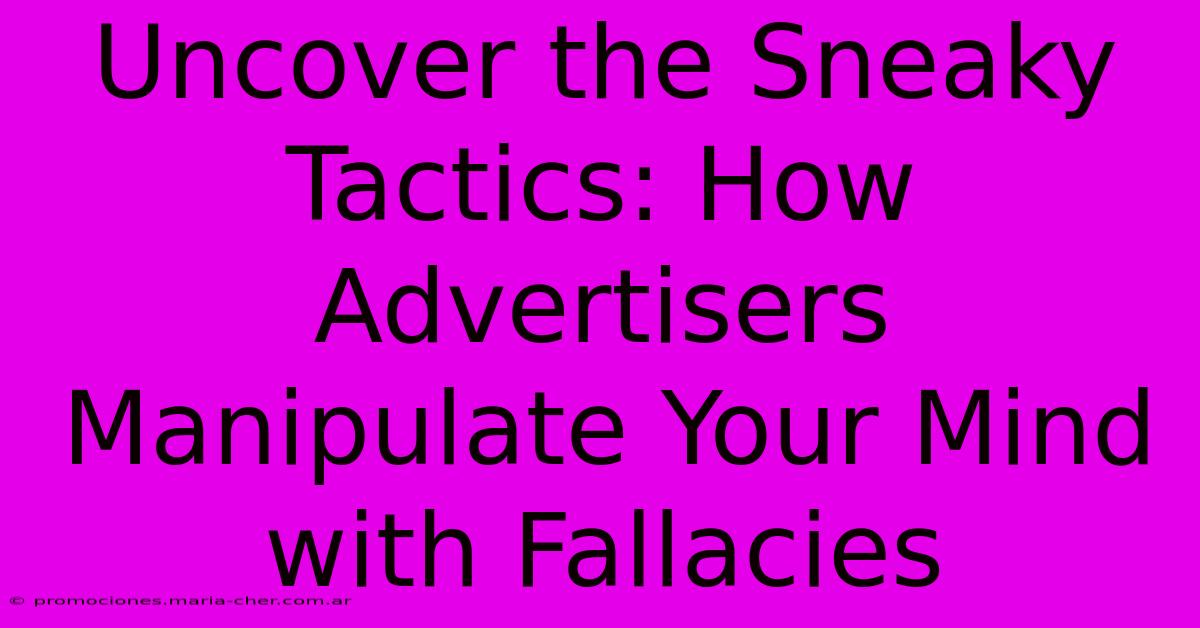Uncover The Sneaky Tactics: How Advertisers Manipulate Your Mind With Fallacies

Table of Contents
Uncover the Sneaky Tactics: How Advertisers Manipulate Your Mind with Fallacies
We're bombarded with advertisements daily. From catchy jingles to stunning visuals, advertisers employ a vast arsenal of techniques to capture our attention and, more importantly, influence our purchasing decisions. But beyond the glitz and glamour, many advertising strategies rely on logical fallacies – flaws in reasoning – to manipulate our minds and subtly nudge us towards buying their products. Understanding these tactics empowers us to become more discerning consumers and resist manipulative marketing.
The Power of Persuasion: Logical Fallacies in Advertising
Advertisers cleverly exploit psychological vulnerabilities and cognitive biases to make their products irresistible. They often achieve this using various logical fallacies, which we'll explore in detail below.
1. Bandwagon Effect: "Everyone's Doing It!"
This fallacy preys on our inherent desire to conform. Advertisements using the bandwagon effect suggest that a product is desirable simply because it's popular. Phrases like "Join the millions who..." or showcasing a large, happy crowd using the product are common examples. This tactic taps into our social nature and fear of missing out (FOMO).
Example: A soda commercial showing a massive, energetic party where everyone is drinking the advertised soda.
2. Appeal to Authority: "Trust the Experts!"
This fallacy leverages the credibility of a trusted figure – often a celebrity or expert – to endorse a product. The implication is that if a respected authority uses or recommends it, the product must be good. However, this doesn't guarantee product quality; the authority might not be an expert in the relevant field or may be paid for their endorsement.
Example: A famous athlete endorsing a sports drink, implying that consuming it will improve athletic performance.
3. False Dilemma/Either-Or Fallacy: "It's This or That!"
This fallacy presents only two options, often extremes, when more possibilities exist. Advertisers might frame the choice as "buy our product or suffer the consequences," neglecting alternative solutions or products. This manipulative tactic limits the consumer's perspective and pushes them towards the desired outcome.
Example: A cleaning product commercial showing a grimy, unpleasant situation and then immediately showcasing their product as the only solution to achieve cleanliness.
4. Appeal to Emotion: Tugging at Your Heartstrings
This tactic uses emotional appeals – fear, joy, sadness, nostalgia – to bypass rational thinking. Heartwarming stories, dramatic visuals, and emotional music are used to create a connection with the consumer and build brand loyalty, often overshadowing the product's actual features or value.
Example: A charity commercial showing distressed animals to evoke sympathy and encourage donations.
5. Red Herring: Distracting from the Real Issue
This involves diverting attention away from a product's shortcomings or weaknesses by focusing on unrelated, appealing aspects. Instead of addressing potential problems, the advertisement focuses on secondary, emotionally charged details to distract the viewer from the actual product's value proposition.
Example: A car commercial highlighting its stylish design and luxurious features while avoiding discussion of its fuel efficiency or reliability.
6. Hasty Generalization: Jumping to Conclusions
This fallacy makes broad claims based on insufficient evidence. An advertisement might use a small sample size or anecdotal evidence to suggest that a product is universally effective or beneficial.
Example: A testimonial from one satisfied customer being presented as evidence that the product is highly effective for everyone.
Becoming a Savvy Consumer: Identifying and Resisting Fallacies
Recognizing these fallacies is crucial for making informed purchasing decisions. By critically evaluating advertisements and questioning their underlying claims, we can avoid being manipulated by deceptive marketing tactics. Ask yourself:
- What is the actual evidence presented?
- Is there a hidden agenda?
- Are they appealing to my emotions rather than logic?
- Are there alternative options being ignored?
By developing critical thinking skills, we can navigate the world of advertising with greater awareness and autonomy, making purchasing choices that truly align with our needs and values. This empowers us to become more informed and resilient consumers, protecting ourselves from manipulative marketing tactics.

Thank you for visiting our website wich cover about Uncover The Sneaky Tactics: How Advertisers Manipulate Your Mind With Fallacies. We hope the information provided has been useful to you. Feel free to contact us if you have any questions or need further assistance. See you next time and dont miss to bookmark.
Featured Posts
-
Confused About Sewed Or Sowed We Ve Got You Covered
Feb 07, 2025
-
Discover The Secrets Of Visconti Sforza A Tarot Revelation For The Modern Age
Feb 07, 2025
-
From Day To Night Gold Vermeil Bracelets For Every Occasion
Feb 07, 2025
-
Transform Your Designs With The Cutting Edge Futura Now Trial
Feb 07, 2025
-
Unleash The Ancient Power Of The Visconti Sforza Discover Your Destiny
Feb 07, 2025
